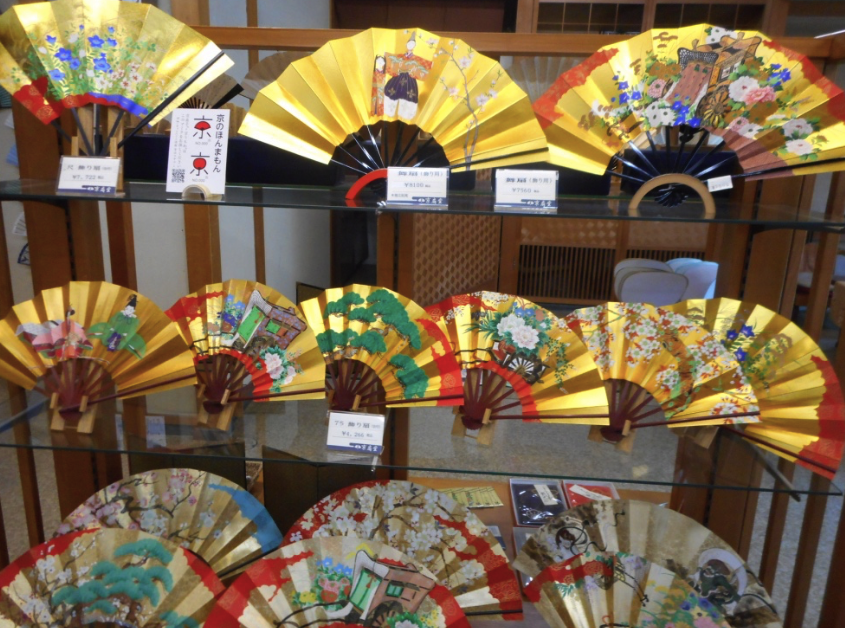Touring Kyoto with locals and on bikes: seeing more than temples

By Eileen Ogintz
The two little Japanese boys are fishing for crawfish in Kyoto’s famous Hirosawanoike Pond. They shyly hold up a claw.
We ride by rice paddies decorated before the September harvest with the funniest scarecrows—a high school baseball player, anime characters, a distinctive Shinto red gate.
Kyoto certainly is famous for its Shinto shrines and Buddhist temples. But this morning, we’re cycling a 14-mile loop with Kyoto Cycling Tour Project with stops at the Golden Pavilion covered in gold leaf with the oldest bonsai tree in Kyoto 20 feet tall and its famous historic Tea Ceremony House and Ryoanji Temple with its world-famous rock garden – two of the city’s and Japan’s top tourist attractions.
What do you see in the rocks? There are 15 but you can only see 14. That’s because, our engaging guide Annie Yamamoto explains, “You can’t be perfect when you are alive. All of the time one of the stones is hiding.”
This garden, she continues—the simple rocks artfully placed in white gravel, offers infinite teaching. And even on this humid day, it is packed with tourists trying to find some of that teaching. Do they see a mother with tiger cubs crossing a river? Do they mean going up to the mountains? This garden was first made in 1500.
We get back on our bikes and cycle through Kyoto neighborhoods where an elderly lady is walking in one place; a mom cycling with her two kids in another. The streets seem almost too narrow for cars.
Our guide, a fit 59-year-old grandmother, also works as a global volunteer ambassador in Kobe—tourists can sign up on line for a free tour by a local guide. She explains that because of the traffic in central Kyoto and so many narrow streets, cycling is the way most locals get around. No one seems to wear bike helmets.
We end up at the city’s famous Bamboo Forest with the tall trees crowded with tourists taking selfies. There has been bamboo here for centuries, our guide explains, but only about a decade ago, the city transformed this area so that it is a must-see for tourists who walk the path between the giant bamboo trees.
I’m glad when we’re back on our bikes, riding along the Oigawa River where locals are strolling on this Saturday afternoon, snacking on ice cream, riding in boats on the river. Our hotel, the Mariott Surian is nearby—it is a mix of east and west—and that night, we sit on the deck watching the locals who ride in the boats to party watching UKAI Cormorant Fishing, bonfires on the boats. Another bit of local culture.
The day before, we’d taken a walking tour that decidedly avoided all of the tourist attractions with Waraido. Ted Ueno, managing director of the two-decade old company explained “we want to show people the real Kyoto, the way people live.”
His company also offers special evening tours introducing Kyoto’s famous Geiko and Maiko culture (they consider the term Geisha demeaning) in the backstreets of the Geisha district another tour introducing the way Japanese eat. Waraido also can arrange private tours throughout Japan.
We walk on a narrow street and stop into a fan shop that makes only fans—some as much as $1800. Folding Fans and Round Fans from Kyoto are traditional crafts used in everyday life and have a history dating back over a thousand years. These beautiful fans are handmade, with one person putting together the wood frame, another painting the fan, another putting it together.
We pass a workshop that produces nothing but tofu. Kyoto is famous for its tofu because it has such good water. There is another tatami mat workshop and in another, an elderly woman is carefully painting pottery. Outside a shuttered shop, are pieces for sale—all you need to do is leave the yen in a box and wrap your find in newspaper. Crime obviously is very low. There is another workshop for making tatami mats used in Japanese homes.
There is a small Shinto gate on the side of a building that is meant to keep drunken men from peeing there. We learn that many in Kyoto live and work in the same place. Kyoto is famous for “long houses” with workshops in the front, living quarters and gardens in the middle and storage in the back. They can stretch for a block!
Our guide Mary Nakai takes us to one of Kyoto’s 300 Shinto Shrines—there are some 1600 Buddhist temples here too. Kyoto is the spiritual center of Japan, many believe, and hard as it is for westerners to understand, most Japanese believe both in Shintoism and Buddhism.
There are Shinto gods for everything from academic achievement to fertility to business success. Students come here, Nakai says, before taking their all-important exams. You put money in the box, ring the bell (to ward off evil spirits), bow twice, clap twice (to attract the gods attention), pray and bow again.
They purchase little wooden cards to hang a wish—some are in English. “I wish my grandmother peace in this life and the next and may all watch over her,” one says.
We write one wishing for health, happiness and peace and—my husband couldn’t resist—adding a plea for the Chicago Cubs to finally win a World Series.





